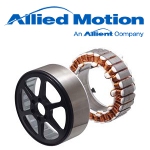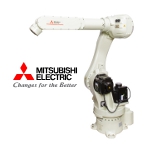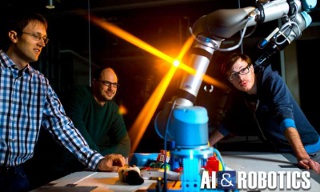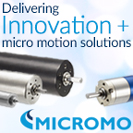 |
| February 20, 2018 | Volume 14 Issue 07 |
Motion Control News & Products
Designfax weekly eMagazine
Archives
Partners
Manufacturing Center
Product Spotlight
Modern Applications News
Metalworking Ideas For
Today's Job Shops
Tooling and Production
Strategies for large
metalworking plants
DURApulse GS30 AC Drives from AutomationDirect
 Automation-Direct has added new high-performance DURApulse GS30 drives that support several control modes including sensorless vector control, closed-loop flux vector control, and torque control in a compact package. The GS30 series expands the DURApulse family by adding internal tension control loop expanded parameter sets for greater versatility, as well as optional EtherCAT and single- or dual-port EtherNet/IP communication cards. GS30 drives support up to four independent induction motor parameter sets or control of a single AC permanent magnet motor. Sizes up to 3 hp for a 230-VAC single-phase input, 50 hp for a 230-VAC three-phase input, and 100 hp for a 460-VAC three-phase input. This series offers PID control, built-in PLC functionality, and STO capability typically found with more expensive high-performance AC drives.
Automation-Direct has added new high-performance DURApulse GS30 drives that support several control modes including sensorless vector control, closed-loop flux vector control, and torque control in a compact package. The GS30 series expands the DURApulse family by adding internal tension control loop expanded parameter sets for greater versatility, as well as optional EtherCAT and single- or dual-port EtherNet/IP communication cards. GS30 drives support up to four independent induction motor parameter sets or control of a single AC permanent magnet motor. Sizes up to 3 hp for a 230-VAC single-phase input, 50 hp for a 230-VAC three-phase input, and 100 hp for a 460-VAC three-phase input. This series offers PID control, built-in PLC functionality, and STO capability typically found with more expensive high-performance AC drives.
Learn more.
Power steering systems for warehouse and autonomous vehicles
 Allied Motion has introduced the electric power steering (EPS) series for steer-by-wire warehouse vehicles, autonomous AGVs, and similar material transport vehicles. This compact system includes a fully integrated motor, gearbox, controller, and optional output pinion. It is available in three frame sizes and 16 models to cover virtually any electric steering requirement in applications from small pallet lifters to AGVs/AGCs to multi-ton reach trucks. An optional, patent-pending feature, Turning Wheel Absolute Position Control, allows the controller to know the turning wheel position without external sensors.
Allied Motion has introduced the electric power steering (EPS) series for steer-by-wire warehouse vehicles, autonomous AGVs, and similar material transport vehicles. This compact system includes a fully integrated motor, gearbox, controller, and optional output pinion. It is available in three frame sizes and 16 models to cover virtually any electric steering requirement in applications from small pallet lifters to AGVs/AGCs to multi-ton reach trucks. An optional, patent-pending feature, Turning Wheel Absolute Position Control, allows the controller to know the turning wheel position without external sensors.
Learn more.
New brushless motors maximize power density
 Allied Motion Technologies has introduced the KinetiMax 95 High Power Drive (HPD), an outer-rotor brushless motor. This frameless motor is designed to maximize power density for its volume with a nominal output torque of 2 Nm at 2,300 RPM, resulting in 480 W of continuous output power. At only 37 mm axial length, this compact stator-rotor set is an ideal solution for applications such as material handling systems, AGVs, mobile robots, handheld power tools, and more.
Allied Motion Technologies has introduced the KinetiMax 95 High Power Drive (HPD), an outer-rotor brushless motor. This frameless motor is designed to maximize power density for its volume with a nominal output torque of 2 Nm at 2,300 RPM, resulting in 480 W of continuous output power. At only 37 mm axial length, this compact stator-rotor set is an ideal solution for applications such as material handling systems, AGVs, mobile robots, handheld power tools, and more.
Learn more.
Compact rod motors: Effective linear thrust generation
 RDM-A Series rod motors from Akribis Systems are great for space-constrained applications requiring high motor forces and smooth linear motion. These compact motors feature a tubular design to distribute magnetic flux evenly along the circumference of the stator. They achieve continuous forces from 2.1 to 137.8 N and peak forces from 6.2 to 413.4 N. An air gap between the coil and magnet track enables non-contact axial linear movement and steady force production over the length of the stroke, and ironless construction ensures cog-free motion.
RDM-A Series rod motors from Akribis Systems are great for space-constrained applications requiring high motor forces and smooth linear motion. These compact motors feature a tubular design to distribute magnetic flux evenly along the circumference of the stator. They achieve continuous forces from 2.1 to 137.8 N and peak forces from 6.2 to 413.4 N. An air gap between the coil and magnet track enables non-contact axial linear movement and steady force production over the length of the stroke, and ironless construction ensures cog-free motion.
Learn more.
NORD's heavy-duty drive systems tackle tough industrial applications
 Industrial gear units from NORD DRIVE-SYSTEMS are used for a variety of heavy-duty applications, providing high output torques and long service life with minimal maintenance. Combining high-efficiency motors and dynamic VFDs, users get high performance and smooth operation. Learn which drive systems are used for which real-world applications in industries including grain, cranes and hoists, wastewater, food and beverage, and bulk material handling. Good info here.
Industrial gear units from NORD DRIVE-SYSTEMS are used for a variety of heavy-duty applications, providing high output torques and long service life with minimal maintenance. Combining high-efficiency motors and dynamic VFDs, users get high performance and smooth operation. Learn which drive systems are used for which real-world applications in industries including grain, cranes and hoists, wastewater, food and beverage, and bulk material handling. Good info here.
Read the full article.
XYZ nanopositioning stage for scanning and positioning in photonics and microscopy
 PI's P-616 XYZ Piezo Nanoposition-ing Stage, based on a parallel-kinematic design, features a single, lightweight moving platform for all three axes. It offers high precision (sub-nanometer resolution) and dynamics in a compact package. Known as the NanoCube®, it is the smallest and lightest system with capacitive feedback, providing a 100-µm linear travel range in three degrees of freedom.
PI's P-616 XYZ Piezo Nanoposition-ing Stage, based on a parallel-kinematic design, features a single, lightweight moving platform for all three axes. It offers high precision (sub-nanometer resolution) and dynamics in a compact package. Known as the NanoCube®, it is the smallest and lightest system with capacitive feedback, providing a 100-µm linear travel range in three degrees of freedom.
Learn more.
Robot with longer reach handles heavier payloads
 The new RV-35/50/80FR robot series from Mitsubishi Electric Automation is ideal for handling large workpieces and heavy objects. This series has a max reach of almost 83 in. (2,100 mm) and a max payload over 175 lb (80 kg), so it's a great solution for palletizing and machine tending. These robots have a wide range of safety functions, including position and speed monitoring, and simplified installation and programming when paired with Mitsubishi Electric's MELFA Smart Plus card.
The new RV-35/50/80FR robot series from Mitsubishi Electric Automation is ideal for handling large workpieces and heavy objects. This series has a max reach of almost 83 in. (2,100 mm) and a max payload over 175 lb (80 kg), so it's a great solution for palletizing and machine tending. These robots have a wide range of safety functions, including position and speed monitoring, and simplified installation and programming when paired with Mitsubishi Electric's MELFA Smart Plus card.
Learn more.
Linear servo press solutions from Tolomatic
 Improve your pressing systems with electric linear actuators from Tolomatic. While hydraulic presses are a traditional choice in many manufacturing applications, a new generation of high-force Linear Servo Press technologies is now replacing high-maintenance hydraulics. They offer significant advantages in precision, programmability, energy efficiency, reliability, and flexibility.
Improve your pressing systems with electric linear actuators from Tolomatic. While hydraulic presses are a traditional choice in many manufacturing applications, a new generation of high-force Linear Servo Press technologies is now replacing high-maintenance hydraulics. They offer significant advantages in precision, programmability, energy efficiency, reliability, and flexibility.
Learn more.
Tech Tip: What is a stepper motor linear actuator?
 What is a stepper motor linear actuator (SMLA), what types are available, and what can they do for your linear motion designs? Find out in this informative Thomson video. Learn how precision lead screws can be combined with a stepper motor in a number of ways, and discover which type can benefit your linear motion applications.
What is a stepper motor linear actuator (SMLA), what types are available, and what can they do for your linear motion designs? Find out in this informative Thomson video. Learn how precision lead screws can be combined with a stepper motor in a number of ways, and discover which type can benefit your linear motion applications.
View the video.
Brakes for high-speed SCARA robots and more
 Precise positioning of semi-conductor wafers during SCARA assembly operations requires instantaneous braking and holding power while minimizing heat in the system. The latest compact and slender Miki Pulley BXR-LE brake models provide the needed, perfectly controlled braking in a confined area of the system using minimal power. The braking response and holding power of this power-off engaged brake makes it ideal for this and other high-speed applications. The BXR-LE brake uses 24 VDC for a split second to overcome compression spring inertia to open the brake, then consumes only 7 VDC by utilizing the BEM power control module.
Precise positioning of semi-conductor wafers during SCARA assembly operations requires instantaneous braking and holding power while minimizing heat in the system. The latest compact and slender Miki Pulley BXR-LE brake models provide the needed, perfectly controlled braking in a confined area of the system using minimal power. The braking response and holding power of this power-off engaged brake makes it ideal for this and other high-speed applications. The BXR-LE brake uses 24 VDC for a split second to overcome compression spring inertia to open the brake, then consumes only 7 VDC by utilizing the BEM power control module.
Learn more.
Automated piece-picking solution
 The MI.RA/ OnePicker is a new and fully automated intelligent piece-picking solution from Comau. The easy-to-use, AI-backed, and collaborative solution reduces upstream process times, saving time, energy, and resources for warehouse, e-commerce, and other applications while increasing overall productivity and cost efficiency. Designed to autonomously pick miscellaneous objects from the same bin, it's a smart way to eliminate unsustainable sorting activities. Comes with Comau's Racer5 six-axis cobot.
The MI.RA/ OnePicker is a new and fully automated intelligent piece-picking solution from Comau. The easy-to-use, AI-backed, and collaborative solution reduces upstream process times, saving time, energy, and resources for warehouse, e-commerce, and other applications while increasing overall productivity and cost efficiency. Designed to autonomously pick miscellaneous objects from the same bin, it's a smart way to eliminate unsustainable sorting activities. Comes with Comau's Racer5 six-axis cobot.
Learn more.
Unlock cost savings: Revolutionary GAM GPL Gearbox
 The GPL planetary gearbox, when paired with your preferred servo motor, delivers a solution that can match the fit and performance of direct drive motors while offering significant cost savings. With <6 arcsec backlash, GAM says this gearbox outperforms all other zero-backlash gearboxes on the market, making it the ideal choice for your applications. Discover how one company realized significant savings by replacing multiple direct drive motors with the GPL gearbox in a modular housing.
The GPL planetary gearbox, when paired with your preferred servo motor, delivers a solution that can match the fit and performance of direct drive motors while offering significant cost savings. With <6 arcsec backlash, GAM says this gearbox outperforms all other zero-backlash gearboxes on the market, making it the ideal choice for your applications. Discover how one company realized significant savings by replacing multiple direct drive motors with the GPL gearbox in a modular housing.
Read the GAM application story.
Bosch Rexroth new linear motor modules
 Fast, compact, and precise. These properties characterize the new linear motor modules (LMM) with integrated screw-free direct drive from Bosch Rexroth. The axes are available in sizes 140, 180, and 220 mm and feature a zero-backlash direct drive. They complement the existing linear motion technology portfolio as a ready-to-install solution offering excellent value for money. The linear motor modules are available in all sizes with iron-core linear motors. Standard strokes are up to 1,540 mm and forces up to 2,400 N.
Fast, compact, and precise. These properties characterize the new linear motor modules (LMM) with integrated screw-free direct drive from Bosch Rexroth. The axes are available in sizes 140, 180, and 220 mm and feature a zero-backlash direct drive. They complement the existing linear motion technology portfolio as a ready-to-install solution offering excellent value for money. The linear motor modules are available in all sizes with iron-core linear motors. Standard strokes are up to 1,540 mm and forces up to 2,400 N.
Learn all the specs and options.
OnRobot doubles payload capacity of its grippers
 OnRobot's new 2FG14 and 3FG25 electrical grippers for heavy-duty, collaborative applications are now launching along with the new machine tending solution AutoPilot powered by D:PLOY, developed in collaboration with Ellison Technologies. The new three-fingered 3FG25 gripper provides users with 25 kg (55.1 lb) of payload power in a compact, all-electric, lightweight form, unlocking the potential of the latest cobots. Ideal for CNC machine tending, the 2FG14 is a lightweight parallel-finger gripper with a payload of 14 kg (30.8 lb). It doubles the payload and gripping force of OnRobot's popular 2FG7 gripper while also providing 30% more total stroke.
OnRobot's new 2FG14 and 3FG25 electrical grippers for heavy-duty, collaborative applications are now launching along with the new machine tending solution AutoPilot powered by D:PLOY, developed in collaboration with Ellison Technologies. The new three-fingered 3FG25 gripper provides users with 25 kg (55.1 lb) of payload power in a compact, all-electric, lightweight form, unlocking the potential of the latest cobots. Ideal for CNC machine tending, the 2FG14 is a lightweight parallel-finger gripper with a payload of 14 kg (30.8 lb). It doubles the payload and gripping force of OnRobot's popular 2FG7 gripper while also providing 30% more total stroke.
Learn more.
Linear guide system corrects misalignments
 Bishop-Wisecarver's UtiliTrak® linear guide system includes vee rails for precision and open rails for misalignment float to provide smooth and accurate motion on inaccurate structures. Because precise parallelism is difficult to achieve, it is not uncommon for mounting surfaces to be slightly out of parallel. UtiliTrak's design compensates for mounting errors and does not require absolute parallelism for accurate operation. Genius.
Bishop-Wisecarver's UtiliTrak® linear guide system includes vee rails for precision and open rails for misalignment float to provide smooth and accurate motion on inaccurate structures. Because precise parallelism is difficult to achieve, it is not uncommon for mounting surfaces to be slightly out of parallel. UtiliTrak's design compensates for mounting errors and does not require absolute parallelism for accurate operation. Genius.
Learn more.
Next big breakthrough in robotics? Northeastern U. researchers say it's all about dexterity

[Credit: Northeastern University]
By Bill Ibelle and Allie Nicodemo, Northeastern University
While drones and driverless cars dominate the headlines, another breakthrough -- robot dexterity -- is likely to have an even greater impact in both business and everyday life.
"Robot manipulation is the next shoe to drop," says Robert Platt, computer science professor and head of the Helping Hands robotics lab at Northeastern. "Imagine a robot that can do things with its hands in the real world -- anything from defusing a bomb to doing your laundry. This has been a dream in the research community for decades, but now we're finally getting to the point where it could actually happen."
Recent advances in machine learning, Big Data, and robot perception have put us on the threshold of a quantum leap in the ability of robots to perform fine motor tasks and function in uncontrolled environments, says Platt.
It's the difference between robots that can do repetitive tasks in a highly structured factory environment and a new era of humanoid robots that can do meaningful work in the real world.
Why fine motor skills have lagged
There's an irony in the field of robots and artificial intelligence known as Moravek's Paradox: What's hard for humans is relatively easy for robots, and what's easy for humans is nearly impossible for robots.
We can program a robot with the computational skills to defeat an international chess champion, but struggle to give it the dexterity of a 2-year-old child. Identifying and grabbing a pencil in a random pile of office supplies is nearly impossible for a robot, and opening a door and walking into a room -- as demonstrated in this recent international robot competition -- can look like a scene from a slapstick comedy.
VIDEO: What happens when robots lack fine motor skills? See lots of droids take a tumble at the DARPA Robotics Challenge Finals in 2015. [Credit: IEEE Spectrum/Northeastern University]
Because humans have been evolving their visual, sensory, and motor skills for millions of years, these complex movements are so deeply ingrained in human circuitry that we perform them unconsciously. In contrast, high-level endeavors such as mathematics, science, and stock analysis are relatively recent human endeavors -- so they're much easier for engineers to replicate.
Poised for a breakthrough
In spite of the enormous challenge, Platt says autonomous robots are poised to make huge leaps in their ability to manipulate unfamiliar objects.
For example, Platt and his team at the Helping Hands Lab have trained a robot to find, grab, and remove unfamiliar objects from a pile of clutter with 93 percent accuracy. Achieving this required significant advances in machine learning, perception, and control.
The researchers used a technique called reinforcement learning in which the robot learns via trial and error. They created a simulated world in which the robot could practice picking up and manipulating objects in virtual reality. When the robot did what the researchers wanted -- grabbed an object from a pile -- it was given a reward. This technique allows the robot to master skills in a virtual environment and then apply them to the real world.
A major advance in depth perception was also essential for robots to work in an uncontrolled environment. Previously, they could only see the world as a flat field of seemingly random colors. But with this new 3D perception, they could identify individual objects in a crowded field.
While vision is an excellent tool for guiding broad movements, fine motor skills require a sense of touch.
"Think of what you can do with gloves on," explains Platt. "You can open the garage door, grab a shovel, and clear the driveway. But if you need to unlock the garage first, you need to take your gloves off to insert the key."
As part of a NASA grant, Platt's lab recently built a robotic hand equipped with tactile sensors and developed new algorithms for interpreting the tactile data.
"In order to insert a key into a lock, the robot needs to know exactly how it's holding the key, down to the millimeter," says Platt. "Our algorithms can localize these kinds of grapsed objects very accurately."
Platt's lab demonstrated these new capabilities by grasping a USB connector and plugging it into a port. While this may not sound like a big deal, it's a critical step toward creating robots that can do precise manipulation tasks such as changing the battery in a cell phone.
What's coming?
As with any fledgling advancement -- radar, the telephone, the internet -- the practical applications of robot dexterity are hard to predict. But here are a few:
Home
Platt's Helping Hands lab -- in collaboration with the University of Massachusetts Lowell and the Crotched Mountain Rehabilitation Facility in New Hampshire -- is building a power wheelchair with a robotic arm that can grasp items around the house or perform simple household tasks. This could enable elderly or people with disabilities to continue to live independently in their homes.
Platt is also interested in adapting this technology for everyday use. "We hear a lot about the Alexa-style assistants that can answer questions by accessing the internet. But these assistants can't do anything physical," says Platt. "We want to equip these devices with a robotic body so you can say, 'Alexa, get the newspaper,' or 'Alexa, clean up Jimmy's room.'"
Outdoors
Engineering professor Hanumant Singh, in collaboration with Platt, is building a golf cart-size mobile robot equipped with a robotic arm that can drive around Northeastern's campus autonomously and perform simple manipulation tasks like taking out the trash.
Military
Similar types of robots could take on similar duties in areas of intense conflict and be used for dangerous operations such as defusing mines. For example, Platt and his group recently completed a grant from the Office of Naval Research to develop fundamental manipulation technologies that will be used aboard Naval vessels.
Hazardous waste
Engineering professor Taskin Padir and his team received a grant from the Department of Energy to adapt NASA's Valkyrie robot for hazardous waste disposal. There are more than a dozen sites scattered around the United States where radioactive waste was buried in tunnels during the Cold War. For autonomous robots to locate, grasp, and place this waste in safe containers, they will need fine motor skills and an ability to operate in unfamiliar environments.
Medicine
Funded by a grant from the National Science Foundation, engineering professor Peter Whitney is working with researchers at Stanford University to create a robot that can perform MRI-guided surgery.
Space exploration
Platt is working with researchers at NASA to develop robotic manipulation capabilities for handling soft objects on future NASA space missions.
"Robots that work flawlessly in the lab break down quickly when they're placed in unfamiliar situations," says Platt. "Our goal is to develop the underlying algorithms that will allow them to be more reliable in the real world. Ultimately, this will fundamentally change the way we think about robots, allowing them to become partners with humans rather than just machines that work in far-away factories."
Published February 2018
Rate this article
View our terms of use and privacy policy

